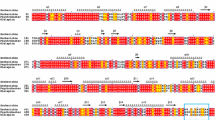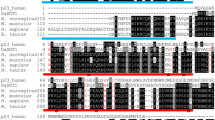Abstract
We investigated the protein folding mechanism of the GroEL system of a psychrophilic bacterium, Colwellia psychrerythraea 34H. The amount of mRNA of the groESL operon of C. psychrerythraea was increased about 6-fold after a temperature upshift from 8 to 18 °C for 30 min, suggesting that this temperature causes heat stress in this bacterium. A σ32-type promoter was found upstream of the groESL, suggesting that the C. psychrerythraea groESL is regulated by the σ32 system, like the groESL in E. coli. The maximum ATPase and CTPase activities of CpGroEL were observed at 45 and 35 °C, respectively, which are much higher than the growth temperatures of C. psychrerythraea. We found that the refolding activity of the CpGroEL system in the presence of ATP is lower than that in the presence of CTP. This suggests that ATP is not the optimum energy source of the CpGroEL system. Analyses for the interaction of CpGroEL–CpGroES revealed that CTP could weaken this interaction, resulting in effective refolding function of the CpGroEL system. From these findings, we consider that the CpGroEL system possesses an energy-saving mechanism for avoiding excess consumption of ATP to ensure growth in a low-temperature environment.







Similar content being viewed by others
Abbreviations
- Cp:
-
Colwellia psychrerythraea
- Ec:
-
Escherichia coli
- HSP:
-
Heat shock protein
- MDH:
-
Malate dehydrogenase
- SR1:
-
Single-ring mutant of E. coli GroEL
- Oa:
-
Oleispira antarctica
- (His6):
-
Hexahistidine
References
Abràmoff MD, Magalhase PJ, Ram SJ (2004) Image processing with ImageJ. Biophotonics Int 11:36–42
Amada K, Yohda M, Odaka M, Endo I, Ishii N, Taguchi H, Yoshida M (1995) Molecular cloning, expression, and characterization of chaperonin-60 and chaperonin-10 from a thermophilic bacterium, Thermus thermophilus HB8. J Biochem 118:347–354
Brocchieri L, Karlin S (2000) Conservation among HSP60 sequences in relation to structure, function, and evolution. Protein Sci 9:476–486
Chaudhuri TK, Farr GW, Fenton WA, Rospert S, Horwich AL (2001) GroEL/GroES-mediated folding of a protein too large to be encapsulated. Cell 107:235–246
Fayet O, Ziegelhoffer T, Georgopoulos C (1989) The groES and groEL heat shock gene products of Escherichia coli are essential for bacterial growth at all temperatures. J Bacteriol 171:1379–1385
Ferrer M, Lünsdorf H, Chernikova TN, Yakimov M, Timmis KN, Golyshin PN (2004) Functional consequences of single:double ring transitions in chaperonins: life in the cold. Mol Microbiol 53:167–182
Hansen JE, Gafni A (1993) Thermal switching between enhanced and arrested reactivation of bacterial glucose-6-phosphate dehydrogenase assisted by GroEL in the absence of ATP. J Biol Chem 268:21632–21636
Hayer-Hartl M (2000) Assay of malate dehydrogenase. A substrate for the E. coli chaperonins GroEL and GroES. Methods Mol Biol 140:127–132
Hengge R, Bukau B (2003) Proteolysis in prokaryotes: protein quality control and regulatory principles. Mol Microbiol 49:1451–1462
Hirai H, Noi K, Hongo K, Mizobata T, Kawata Y (2008) Functional characterization of the recombinant group II chaperonin α from Thermoplasma acidophilum. J Biochem 143:505–515
Höll-Neugebauer B, Rudolph R, Schmidt M, Buchner J (1991) Reconstitution of a heat shock effect in vitro: influence of GroE on the thermal aggregation of α-glucosidase from yeast. Biochemistry 30:11609–11614
Horwich AL, Farr GW, Fenton WA (2006) GroEL–GroES-mediated protein folding. Chem Rev 106:1917–1930
Huston AL, Krieger-Brockett BB, Deming JW (2000) Remarkably low temperature optima for extracellular enzyme activity from Arctic bacteria and sea ice. Environ Microbiol 2:383–388
Huston AL, Methe B, Deming JW (2004) Purification, characterization, and sequencing of an extracellular cold-active aminopeptidase produced by marine psychrophile Colwellia psychrerythraea strain 34H. Appl Environ Microbiol 70:3321–3328
Huston AL, Haeggström JZ, Feller G (2008) Cold adaptation of enzymes: structural, kinetic and microcalorimetric characterizations of an aminopeptidase from the Arctic psychrophila Colwellia psychrerythraea and of human leukotriene A4 hydrolase. Biochim Biophys Acta 1784:1865–1872
Kawata Y, Nosaka K, Hongo K, Mizobata T, Nagai J (1994) Chaperonin GroE and ADP facilitate the folding of various proteins and protect against heat inactivation. FEBS Lett 345:229–232
Kerner MJ, Naylor DJ, Ishihama Y, Maier T, Chang HC, Stines AP, Georgopoulos C, Frishman D, Hayer-Hartl M, Mann M, Hartl FU (2005) Proteome-wide analysis of chaperonin-dependent protein folding in Escherichia coli. Cell 122:209–220
Kodama T, Fukui K, Kometani K (1986) The initial phosphate burst in ATP hydrolysis by myosin and subfragment-1 as studied by a modified malachite green method for determination of inorganic phosphate. J Biochem 99:1465–1472
Kubo T, Mizobata T, Kawata Y (1993) Refolding of yeast enolase in the presence of the chaperonin GroE. J Biol Chem 268:19346–19351
Kumar CMS, Khare G, Srikanth CV, Tyagi AK, Sardesai AA, Mande SC (2009) Facilitated oligomeraization of mycobacterial GroEL: evidence for phosphorylation-mediated oligomerization. J Bacteriol 191:6525–6538
Lanzetta PA, Alvarez LJ, Reinach PS, Candia OA (1979) An improved assay for nanomole amounts of inorganic phosphate. Anal Biochem 100:95–97
Machida K, Fujiwara R, Tanaka T, Sakane I, Hongo K, Mizobata T, Kawata Y (2009) Gly192 at hinge 2 site in the chaperonin GroEL plays a pivotal role in the dynamic apical domain movement that leads to GroES binding and efficient encapsulation of substrate proteins. Biochim Biophys Acta 1794:1344–1354
Miller AD, Maghlaoui K, Albanese G, Kleinjan DA, Smith C (1993) Escherichia coli chaperonins Cpn60 (groEL) and Cpn10 (groES) do not catalyse the refolding of mitochondrial malate dehydrogenase. Biochem J 291:139–144
Okuda H, Sakuhana C, Yamamoto R, Mizukami Y, Kawai R, Sumita Y, Koga M, Shirai M, Matsuda K (2008) The intermediate domain defines broad nucleotide selectivity for protein folding in Chlamydophila GroEL1. J Biol Chem 283:9300–9307
Paul S, Singh C, Mishra S, Chaudhuri TK (2007) The 69 kDa Escherichia coli maltodextrin glucosidase does not get encapsulated underneath GroES and folds through trans mechanism during GroEL/GroES-assisted folding. FASEB J 21:2874–2885
Richter K, Haslbeck M, Buchner J (2010) The heat shock response: life on the verge of death. Mol Cell 40:253–266
Roseman AM, Chen S, White H, Braig K, Saibil HR (1996) The chaperonin ATPase cycle: mechanism of allosteric switching and movements of substrate-binding domains in GroEL. Cell 87:241–251
Sakamoto T, Higashi S, Wada H, Murata N, Bryant DA (1997) Low-temperature-induced desaturation of fatty acids and expression of desaturase genes in the cuanobacterium Synechococcus sp. PCC 7002. FEMS Microbiol Lett 152:313–320
Tang YC, Chang HC, Chakraborty K, Hartl FU, Hayer-Hartl M (2008) Essential role of the chaperonin folding compartment in vivo. EMBO J 27:1458–1468
Todd MJ, Viitanen PV, Lorimer GH (1993) Hydrolysis of adenosine 5′-triphosphate by Escherichia coli GroEL: effects of GroES and potassium ion. Biochemistry 32:8560–8567
Tosco A, Birolo L, Madonna S, Lolli G, Sannia G, Marino G (2003) GroEL from the psychrophilic bacterium Pseudoalteromonas haloplanktis TAC 125: molecular characterization and gene cloning. Extremophiles 7:17–28
Walter S, Buchner J (2002) Molecular chaperones-cellular machines for protein folding. Angew Chem Int Ed 41:1098–1113
Weissman JS, Hohl CM, Kovalenko O, Kashi Y, Chen S, Braig K, Saibil HR, Fenton WA, Horwich AL (1995) Mechanism of GroEL action: productive release of polypeptide from a sequestered position. Cell 83:577–587
Weissman JS, Rye HS, Fenton WA, Beechem JM, Horwich AL (1996) Characterization of the active intermediate of a GroEL–GroES-mediated protein folding reaction. Cell 84:481–490
Xu Z, Horwich AL, Sigler PB (1997) The crystal structure of the asymmetric GroEL–GroES–(ADP)7 chaperonin complex. Nature 388:741–750
Yamanaka K (1999) Cold shock response in Escherichia coli. J Mol Microbiol Biotechnol 1:193–202
Yamauchi S, Okuyama H, Morita EH, Hayashi H (2003) Gene structure and transcriptional regulation specific to the groESL operon from the psychrophilic bacterium Colwellia maris. Arch Microbiol 180:272–278
Yamauchi S, Okuyama H, Nishiyama Y, Hayashi H (2004) Gene structure and transcriptional regulation of dnaK and dnaJ genes from a psychrophilic bacterium, Colwellia maris. Extremophiles 8:283–290
Yamauchi S, Okuyama H, Nishiyama Y, Hayashi H (2006) The rpoH gene encoding heat shock sigma factor σ32 of psychrophilic bacterium Colwellia maris. Extremophiles 10:149–158
Yoshida T, Kawaguchi R, Maruyama T (2002) Nucleotide specificity of an archaeal group II chaperonin from Thermococcus strain KS-1 with reference to the ATP-dependent protein folding cycle. FEBS Lett 514:269–274
Author information
Authors and Affiliations
Corresponding author
Additional information
Communicated by L. Huang.
Electronic supplementary material
Below is the link to the electronic supplementary material.
Rights and permissions
About this article
Cite this article
Yamauchi, S., Ueda, Y., Matsumoto, M. et al. Distinct features of protein folding by the GroEL system from a psychrophilic bacterium, Colwellia psychrerythraea 34H. Extremophiles 16, 871–882 (2012). https://doi.org/10.1007/s00792-012-0483-7
Received:
Accepted:
Published:
Issue Date:
DOI: https://doi.org/10.1007/s00792-012-0483-7




